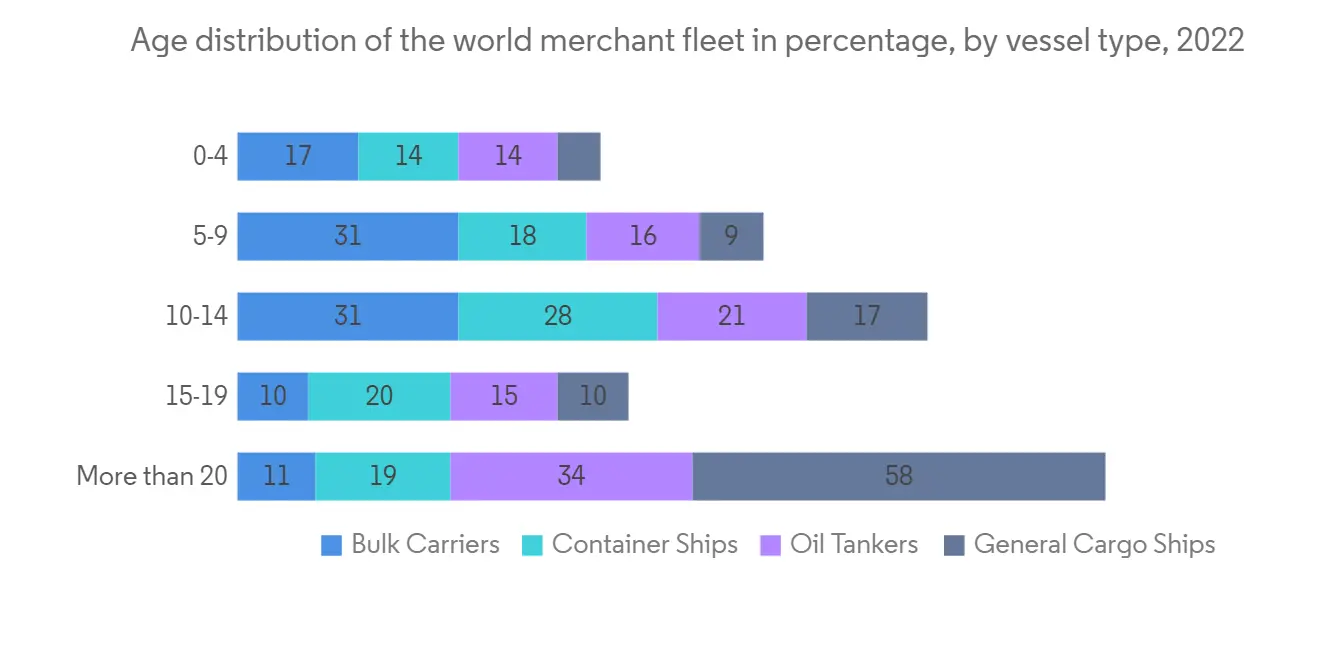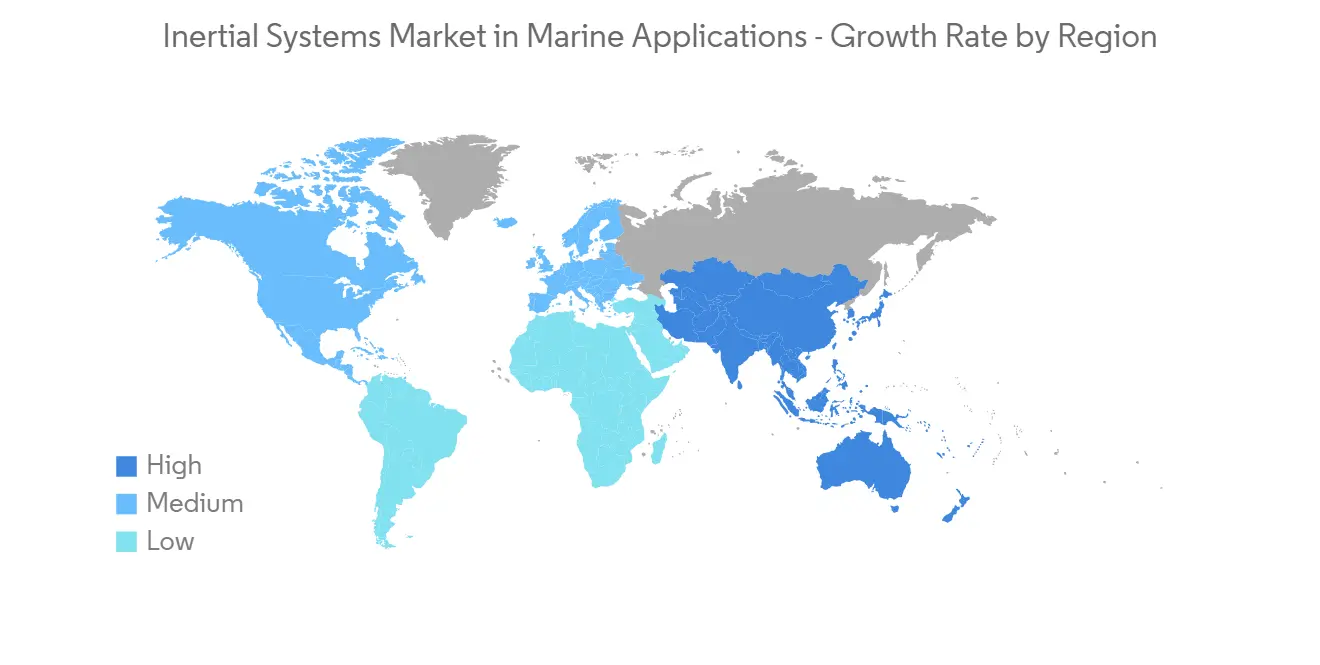 |
市場調査レポート
商品コード
1258775
海洋アプリケーション向け慣性システム市場- 成長、動向、予測(2023年-2028年)Marine Applications Inertial Systems Market - Growth, Trends, and Forecasts (2023 - 2028) |
||||||
● お客様のご希望に応じて、既存データの加工や未掲載情報(例:国別セグメント)の追加などの対応が可能です。 詳細はお問い合わせください。
| 海洋アプリケーション向け慣性システム市場- 成長、動向、予測(2023年-2028年) |
|
出版日: 2023年04月14日
発行: Mordor Intelligence
ページ情報: 英文 120 Pages
納期: 2~3営業日
|
- 全表示
- 概要
- 目次
海洋アプリケーション向け慣性システム市場は、予測期間中に10.31%のCAGRで推移すると予想されています。
世界のライフスタイルの急速な進歩により、慣性センサーを多用したモーションセンシング技術によって、より簡単に操作できる機器が生み出されています。
主なハイライト
- MEMSベースのソリューションは,誤差特性の改善,環境安定性,帯域幅の拡大,G感度の向上,および高度なフュージョンとセンサー誤差モデリングアルゴリズムを実行するための組み込みコンピューティングパワーの利用可能性が高まっていることから,過去数年間,ナビゲーション分野で人気を集めています.ベンダーはFOGからMEMS技術に切り替えつつあり、アンテナアレイの安定化アプリケーションもそれに追随しているようです。
- MEMSベースのナビゲーションシステムと従来のFOGやRLGナビゲーションシステムとの間のコスト差は、MEMSベースのナビゲーションシステムが1,000米ドルであるのに対し、3万米ドル以上であるため、MEMSベースシステムの成長を促す主な要因の1つとなっています。しかし、市場にある他のシステムと比較すると、FOGおよびRLGベースのソリューションはより高い精度を提供します。
- また、モーション・センシングに基づくアプリケーションの増加も、市場を牽引しています。センサーや関連部品の小型化が進み、高機能なセンサーへの移行が進んでいます。例えば、Xsens社では、モーション・センシングの慣性計測ユニット(IMU)モジュールをMTi 1シリーズから改良し、ロール、ピッチ、ヨーの計測精度を向上させ、さまざまなエネルギー・インフラプロジェクトにおいて第一世代の製品よりも機械的ストレスに対する耐性を高めています。
- INSシステムは、購入、運用、保守を含めた価格が難点です。その他の欠点としては、熱放散や、時間の経過とともにエスカレートする航法ミスなどがあります。サイズ、重量、電力の基準は、技術の進歩に伴い減少するもの、GPS受信機の基準よりまだ大きいです。
- COVID-19の発生により、多くの商業・非商業的な業務が停止しています。海運業は、この感染症の影響を大きく受けている企業の一つです。COVID-19の蔓延を食い止めるため、安全上の理由から労働力が削減されたため、海運・海事部門は考えうる限り最悪の状況に追い込まれています。
海洋アプリケーション向け慣性システムの市場動向
高精度な慣性システムに対するニーズの高まりが市場の成長を促進する
- 海洋慣性システムは、自律型水中航行体(AUV)、無人水中航行体(UUV)、無人水上ボート、遠隔操作船(ROV)などの無人海洋・海上システムに方位、位置、速度のデータを提供します。水上・海中の自律航行は、正確な方位、速度、ピッチ、ロール、位置情報に依存するため、海洋INSは不可欠です。また、UUVやUSVが波立つ海域で定位置と安定性を維持し、ROVのオペレーターに自機がどこにいるべきかの情報を提供するのにも役立っています。
- 例えば、シリコンセンシングシステムズは、急速に拡大するオフショア分野の需要に応えるために、これらの技術を活用してきた長い歴史を持っています。同社は、さまざまなハイテク用途向けに、業界をリードするMEMSベースの慣性センサーを設計・製造しています。船舶、潜水艦、その他の海上交通機関の正確な動きや位置を監視・制御するために必要なシステムには、MEMS慣性センサーが含まれています。
- MEMS技術の発展と、航行精度への要求の高まりが、慣性センサーの成長をもたらしたといえます。ナビゲーショナルシステムでは、大きな市場シェアが見込まれます。海軍用慣性計測装置(IMU)のバイアス安定度は、短期航法で0.05~0.5ツー/h、高級航法で0.0001~0.01ツー/hです。

アジア太平洋地域が市場の急成長地域となる見込み
- アジア太平洋地域には、世界でも有数の経済成長率を誇る中国とインドがあります。国際貿易の大半を占める海上航路を持つこれらの国々の商業的交流が、海上輸送ビジネスの成長を牽引しています。
- 世界のコンテナ港湾荷役の動向は、アジアが世界の貿易と輸送において圧倒的な地位を占めていることを示しています。アジア諸国では、地域内貿易が大幅に増加しており、その多くは製造業によるもので、部品がアジアの多くの場所で生産され、別の場所で組み立てられるという分散した生産プロセスを反映しています。
- エネルギー政策が変化し、オーストラリアや米国の輸出能力が拡大したこともあり、需要増の大半はアジアからのものです。複雑で革新的な加速度ピックアップの製造に企業が投資しているため、新しい高性能の加速度ピックアップがこの地域で開発されつつあります。貿易は、海上輸送に後押しされて増加すると予想されます。

海洋アプリケーション向け慣性システムの産業概要
様々な慣性システムソリューションプロバイダーが存在するため、市場は部分的に断片化されています。しかし、ベンダーは一貫して製品開発に注力し、知名度と世界な存在感を高めています。また、市場の牽引力を高め、市場シェアを拡大するために、戦略的パートナーシップや買収も行っています。主なプレーヤーは、Honeywell International Inc.、Bosch Sensortec GmbH、Northrop Grumman Corporation、ST Microelectronicsなどです。
- 2022年9月- Groupe Gorgeは、iXblueの買収が大きな成果であったと発表しました。ECAグループとiXblueの合併は、ロボティクス、海洋、ナビゲーション、航空宇宙、フォトニクスにおける欧州のハイテク産業リーダーの出現に貢献します。お客様には、iXblueとECA Groupから、シンプルな部品から複雑なシステムまで、厳しい地形での重要な活動をサポートする特別なオファーをお届けします。
その他の特典:
- エクセル形式の市場予測(ME)シート
- 3ヶ月のアナリストサポート
目次
第1章 イントロダクション
- 調査の前提条件と市場定義
- 調査対象範囲
第2章 調査手法
第3章 エグゼクティブサマリー
第4章 マーケット洞察
- 市場概要
- バリューチェーン/サプライチェーン分析
- 産業の魅力- ポーターのファイブフォース分析
- 新規参入業者の脅威
- 買い手の交渉力
- 供給企業の交渉力
- 代替品の脅威
- 競争企業間の敵対関係の強さ
- COVID-19の業界への影響度評価
第5章 市場力学
- 市場促進要因
- MEMS技術の登場
- モーションセンサーに基づくアプリケーションの増加
- 市場抑制要因
- 積算ドリフト誤差
第6章 市場セグメンテーション
- コンポーネント別
- 加速度センサー
- IMU
- ジャイロスコープ
- 磁力計
- アティチュードヘディング
- リファレンスシステム
- 地域別
- 北米
- 欧州
- アジア太平洋地域
- 世界のその他の地域
第7章 競合情勢
- 企業プロファイル
- Honeywell International Inc.
- Northrop Grumman Corporation
- Rockwell Collins
- Bosch Sensortec GmbH
- ST Microelectronics
- Safran Group
- SBG Systems
- Raytheon Anschtz GmbH
- KVH Industries Inc.
- Silicon Sensing Systems Ltd
- Vector NAV
第8章 投資分析
第9章 市場の将来性
The inertial system market in marine applications is expected to record a CAGR of 10.31% over the forecast period. The rapid advancement of the global lifestyle has produced easier equipment to operate, accomplished with the use of motion-sensing technology that heavily utilizes inertial sensors.
Key Highlights
- MEMS-based solutions have gained popularity in the navigation sector over the past few years due to improved error characteristics, environmental stability, increased bandwidth, improved g-sensitivity, and the growing accessibility of embedded computing power to run sophisticated fusion and sensor error modeling algorithms. Vendors are switching from FOG to MEMS technology, and antenna array stabilization applications appear to follow suit.
- The cost differential between MEMS-based systems and conventional FOG or RLG navigation systems, which cost over USD 30,000 instead of USD 1,000 for MEMS-based navigation systems, is one of the main factors driving growth in MEMS-based systems. However, compared to other systems on the market, FOG- and RLG-based solutions provide more precision.
- The market is also being driven by an increase in applications based on motion sensing. The ongoing downsizing of sensors and related components is concentrating progress toward sophisticated function sensors. For instance, Xsens improved versions of its motion-sensing Inertial Measurement Unit (IMU) modules from the MTi 1-series, which offer improved roll, pitch, and yaw measurement accuracy and higher tolerance of mechanical stress compared to the first generation of the product in various energy and infrastructure projects.
- The price of INS systems, including purchase, operation, and maintenance, is a drawback. Other drawbacks include heat dissipation and escalating navigational mistakes over time. The size, weight, and power criteria are still greater than those for GPS receivers, although they decrease over time as technology advances.
- Numerous commercial and non-commercial operations have been put on hold due to the COVID-19 outbreak. The shipping and maritime sector is one of the businesses severely impacted by the outbreak. Since their workforces have been curtailed for safety reasons and to stop the spread of COVID-19, the pandemic has left the shipping and maritime sectors in the worst conceivable position.
Marine Applications Inertial Systems Market Trends
Evolving Need for High-Accuracy Inertial Systems Driving the Growth of the Market
- Marine inertial systems provide orientation, position, and velocity data to unmanned marine and maritime systems, such as autonomous underwater vehicles (AUVs), unmanned underwater vehicles (UUVs), unmanned surface boats, and remotely operated vehicles (ROVs). Since autonomous surface and underwater navigation depend on exact heading, velocity, pitch, roll, and location data, marine INS is essential. They also help UUVs and USVs maintain their station and stability in choppy waters while providing information to ROV operators on where their craft should be.
- Silicon Sensing Systems, for instance, has a long history of using these technologies to meet the demands of quickly expanding offshore sectors. The company designs and manufactures industry-leading MEMS-based inertial sensors for a range of high-tech applications. The systems required to monitor and control precise motion and position on ships, submarines, and other maritime vehicles include MEMS inertial sensors.
- The development of MEMS technology and the increased demand for navigational accuracy can be credited with the growth of inertial systems. A sizeable market share is anticipated for navigational systems. Inertial measurement units (IMUs) utilized for naval applications have bias stability of 0.05-0.5 °/h for short-term navigation and 0.0001-0.01 °/h for high-grade navigation.

Asia-Pacific is Expected to be the Fastest-Growing Region in the Market
- The Asia-Pacific region includes China and India, two of the world's economies with the highest growth rates. Commercial interactions between these nations, whose maritime routes make up the majority of international commerce, drive the growth of the marine transportation business.
- Trends in container port-handling operations worldwide show Asia's dominant global trade and transportation position. Asian countries are seeing a major increase in intra-regional trade, mostly driven by manufacturing trade and reflecting dispersed production processes where components are produced in many locations throughout Asia and assembled in another.
- Most of the increased demand came from Asia, helped by ongoing changes to energy policy and expanded export capacity in Australia and the United States. New, high-performance accelerometers are developing in the region as businesses invest in creating complex and innovative accelerometers. Trade is expected to increase, boosted by marine transportation.

Marine Applications Inertial Systems Industry Overview
The market is partially fragmented due to the presence of various inertial systems solution providers. However, vendors consistently focus on product development to enhance their visibility and global presence. The companies are also undergoing strategic partnerships and acquisitions to gain market traction and increase market share. The key players are Honeywell International Inc., Bosch Sensortec GmbH, Northrop Grumman Corporation, ST Microelectronics, etc.
- September 2022 - Groupe Gorge announced that the acquisition of iXblue was a significant accomplishment. The merger between ECA Group and iXblue will help in the emergence of a European high-tech industrial leader in robotics, marine, navigation, aerospace, and photonics. Customers will receive a special offer from iXblue and ECA Group that ranges from simple components to intricate systems to support important operations in challenging terrain.
Additional Benefits:
- The market estimate (ME) sheet in Excel format
- 3 months of analyst support
TABLE OF CONTENTS
1 INTRODUCTION
- 1.1 Study Assumptions and Market Definition
- 1.2 Scope of the Study
2 RESEARCH METHODOLOGY
3 EXECUTIVE SUMMARY
4 MARKET INSIGHTS
- 4.1 Market Overview
- 4.2 Value Chain/Supply Chain Analysis
- 4.3 Industry Attractiveness - Porter's Five Forces Analysis
- 4.3.1 Threat of New Entrants
- 4.3.2 Bargaining Power of Buyers
- 4.3.3 Bargaining Power of Suppliers
- 4.3.4 Threat of Substitute Products
- 4.3.5 Intensity of Competitive Rivalry
- 4.4 Assessment of COVID-19 Impact on the Industry
5 MARKET DYNAMICS
- 5.1 Market Drivers
- 5.1.1 Emergence of MEMS Technology
- 5.1.2 Increasing Applications Based on Motion Sensing
- 5.2 Market Restraints
- 5.2.1 Integration Drift Error
6 MARKET SEGMENTATION
- 6.1 By Component
- 6.1.1 Accelerometers
- 6.1.2 IMUs
- 6.1.3 Gyroscopes
- 6.1.4 Magnetometer
- 6.1.5 Attitude Heading
- 6.1.6 Reference Systems
- 6.2 By Geography
- 6.2.1 North America
- 6.2.2 Europe
- 6.2.3 Asia-Pacific
- 6.2.4 Rest of the World
7 COMPETITIVE LANDSCAPE
- 7.1 Company Profiles
- 7.1.1 Honeywell International Inc.
- 7.1.2 Northrop Grumman Corporation
- 7.1.3 Rockwell Collins
- 7.1.4 Bosch Sensortec GmbH
- 7.1.5 ST Microelectronics
- 7.1.6 Safran Group
- 7.1.7 SBG Systems
- 7.1.8 Raytheon Anschtz GmbH
- 7.1.9 KVH Industries Inc.
- 7.1.10 Silicon Sensing Systems Ltd
- 7.1.11 Vector NAV
